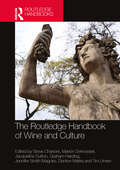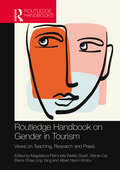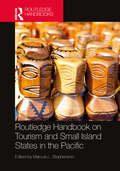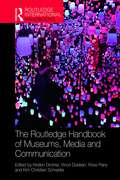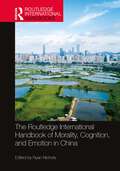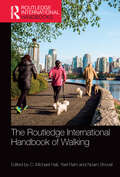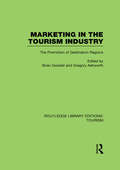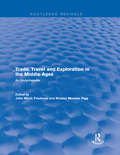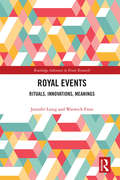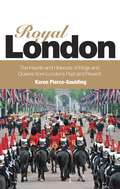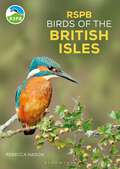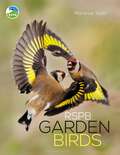- Table View
- List View
The Routledge Handbook of Volunteering in Events, Sport and Tourism
by Kirsten Holmes Leonie Lockstone-Binney Karen A. Smith Richard ShipwayThis timely handbook examines the most contemporary, controversial and cutting-edge issues related to the involvement of volunteers in the fields of events, sport and tourism. Split into thematic sections, the primary areas covered include: key disciplinary approaches to understanding volunteerism, international contexts, managing volunteers, the impacts and legacies of volunteering and future trends in these sectors including online and digital volunteering. Commonalities and differences of volunteering in these sectors are drawn out throughout the volume. A diverse range of case studies are examined including the 2007 UEFA Under 21 Championship hosted by Poland, the development of the Appalachian National Scenic Trail, the Vancouver, London and Pyeong Chang Olympic Games, Belgium’s National Day in 2019, the Puffing Billy railway in Australia, as well as many other examples looking at destination services organizations, museums, grassroots associations, corporate events, community events and visitor attractions. Drawing on the academic and practical expertise of over 50 authors from across the globe, the handbook provides an invaluable resource for all those with an interest in volunteering in these sectors, encouraging dialogue across disciplinary boundaries and areas of study in order to advance volunteering research and practice in the fields of events, sport and tourism.
The Routledge Handbook of Wine and Culture
by Steve Charters Marion Demossier Jacqueline Dutton Graham Harding Jennifer Smith Maguire Denton Marks Tim UnwinThe link between culture and wine reaches back into the earliest history of humanity. The Routledge Handbook of Wine and Culture brings together a newly comprehensive, interdisciplinary overview of contemporary research and thinking on how wine fits into the cultural frameworks of production, intermediation and consumption. Bringing together many leading researchers engaged in studying these phenomena, it explores the different ways in which wine is constructed as a social artefact and how its representation and use acquire symbolic meaning. Wine can be analysed in different ways by varying disciplines involved in exploring wine and culture (anthropology, economics and business, geography, history and sociology, and as text). The Handbook uses these as lenses to consider how producers, intermediaries and consumers use and create cultural significance. Specifically, the work addresses the following: how wine relates to place, belief systems and accompanying rituals; how it may be used as a marker of the identity and mechanisms of civilising processes (often in conjunction with food and the arts); how its framing intersects with science and nature; the ideologies and power relations which arise around all these activities; and the relation of this to wine markets and public institutions. This is essential reading for researchers and students in education for the wine industry and in the humanities and social sciences engaged in understanding patterns of human ingenuity and interaction, such as sociology, anthropology, health, geography, business, tourism, cultural studies, food studies and history.
The Routledge Handbook of Wine and Culture
by Steve Charters Marion Demossier Jacqueline Dutton Graham Harding Jennifer Smith Maguire Denton Marks Tim UnwinThe link between culture and wine reaches back into the earliest history of humanity. The Routledge Handbook of Wine and Culture brings together a newly comprehensive, interdisciplinary overview of contemporary research and thinking on how wine fits into the cultural frameworks of production, intermediation and consumption. Bringing together many leading researchers engaged in studying these phenomena, it explores the different ways in which wine is constructed as a social artefact and how its representation and use acquire symbolic meaning. Wine can be analysed in different ways by varying disciplines involved in exploring wine and culture (anthropology, economics and business, geography, history and sociology, and as text). The Handbook uses these as lenses to consider how producers, intermediaries and consumers use and create cultural significance. Specifically, the work addresses the following: how wine relates to place, belief systems and accompanying rituals; how it may be used as a marker of the identity and mechanisms of civilising processes (often in conjunction with food and the arts); how its framing intersects with science and nature; the ideologies and power relations which arise around all these activities; and the relation of this to wine markets and public institutions. This is essential reading for researchers and students in education for the wine industry and in the humanities and social sciences engaged in understanding patterns of human ingenuity and interaction, such as sociology, anthropology, health, geography, business, tourism, cultural studies, food studies and history.
Routledge Handbook of Wine Tourism
by Saurabh Kumar DixitWine tourism or enotourism or oenotourism or winery tourism or vinitourism is a special interest tourism that empowers local culture and spawns business opportunities for the local community. The comprehensive Routledge Handbook of Wine Tourism offers a thorough inquiry into both regular and emerging issues of wine tourism. Modern wine tourism extends beyond the mere cultivation of grapes and the production and selling of wine. The Routledge Handbook of Wine Tourism examines the complex interplay of market profiling, sustainable regional development, and innovative experiential marketing constructs which, when successful, contribute to the growth and sustainable evolution of global wine tourism. This handbook examines how the success of various enotourism events such as vineyard visits, winery tours, wine festivals and wine trails can stimulate the development of wine-producing regions and territories. Incorporating the latest philosophies and research themes, this handbook will be an essential reference for students, researchers, academics and industry practitioners of hospitality and tourism, gastronomy, management, marketing, cultural studies, development studies, international business and for encouraging dialogue across disciplinary boundaries.
Routledge Handbook of Wine Tourism
by Saurabh Kumar DixitWine tourism or enotourism or oenotourism or winery tourism or vinitourism is a special interest tourism that empowers local culture and spawns business opportunities for the local community. The comprehensive Routledge Handbook of Wine Tourism offers a thorough inquiry into both regular and emerging issues of wine tourism. Modern wine tourism extends beyond the mere cultivation of grapes and the production and selling of wine. The Routledge Handbook of Wine Tourism examines the complex interplay of market profiling, sustainable regional development, and innovative experiential marketing constructs which, when successful, contribute to the growth and sustainable evolution of global wine tourism. This handbook examines how the success of various enotourism events such as vineyard visits, winery tours, wine festivals and wine trails can stimulate the development of wine-producing regions and territories. Incorporating the latest philosophies and research themes, this handbook will be an essential reference for students, researchers, academics and industry practitioners of hospitality and tourism, gastronomy, management, marketing, cultural studies, development studies, international business and for encouraging dialogue across disciplinary boundaries.
Routledge Handbook on Gender in Tourism: Views on Teaching, Research and Praxis
by Magdalena Petronella Swart Wenjie Cai Yang, Elaine Chiao Ling Albert Nsom KimbuThis comprehensive handbook delves into the multifaceted dimensions of the role of gender in tourism, spanning education, research, and practice. With 40 international contributions from leading thinkers in the field, this book brings together diverse themes such as entrepreneurship, mobility, sustainability, and sexuality. In doing so it shatters traditional boundaries and dissects how gender influences perceptions, experiences, and opportunities, advocating for equality and challenging entrenched power dynamics. Informed by the United Nation's Gender Equality goals, this handbook champions the potential of gender-aware tourism to reshape the world by fostering inclusivity, empowerment, and understanding. It adopts diverse insights, encompassing feminist and queer perspectives, challenging norms, and exploring marginalised voices. By dissecting gender in educational, entrepreneurial, and research contexts, it unveils hidden dynamics. This book empowers readers to grasp the breadth of gender's role and equips them with tools to foster equality and reshape the tourism landscape, while making suggestions for future research agendas.This book is intended for scholars, educators, researchers, government officials and practitioners in the fields of gender studies, tourism, education, entrepreneurship, employment, mobility, research, sustainability, and sexuality.
Routledge Handbook on Gender in Tourism: Views on Teaching, Research and Praxis
This comprehensive handbook delves into the multifaceted dimensions of the role of gender in tourism, spanning education, research, and practice. With 40 international contributions from leading thinkers in the field, this book brings together diverse themes such as entrepreneurship, mobility, sustainability, and sexuality. In doing so it shatters traditional boundaries and dissects how gender influences perceptions, experiences, and opportunities, advocating for equality and challenging entrenched power dynamics. Informed by the United Nation's Gender Equality goals, this handbook champions the potential of gender-aware tourism to reshape the world by fostering inclusivity, empowerment, and understanding. It adopts diverse insights, encompassing feminist and queer perspectives, challenging norms, and exploring marginalised voices. By dissecting gender in educational, entrepreneurial, and research contexts, it unveils hidden dynamics. This book empowers readers to grasp the breadth of gender's role and equips them with tools to foster equality and reshape the tourism landscape, while making suggestions for future research agendas.This book is intended for scholars, educators, researchers, government officials and practitioners in the fields of gender studies, tourism, education, entrepreneurship, employment, mobility, research, sustainability, and sexuality.
Routledge Handbook on Tourism and Small Island States in the Pacific
by Marcus L. StephensonThis timely handbook critically examines the development and role of tourism in small Pacific Island states located across Melanesia, Micronesia and Polynesia. The volume presents an expansive evaluation of current issues, challenges and potentialities for the 13 self-governing states. Interdisciplinary in coverage and borne of a varied and international authorship, this handbook incorporates 27 specifically commissioned and original contributions. Structured into four thematic sections and embellished with insightful tables and illustrations throughout, the overarching ethos of this volume is to contribute to framing the role of tourism, tourism development and the tourism industry within the context of self-governing Pacific Island states faced with the challenge of pursuing an independent path of development. In doing so, the work highlights and deciphers various tourism development perplexities in the Pacific, examining closely the intersecting sociocultural, geopolitical, environmental, organizational, operational and strategic challenges. This volume, thus, discusses a range of issues: facilitators and inhibitors of tourism growth and development; climate change, ecological concerns, and eco-tourism; non-tourism and undertourism; crisis management and the COVID-19 virus; transportation and tourism infrastructural concerns; tourism policy and planning (including tourism governance); sectoral links between tourism; food and agriculture; gender and micro-entrepreneurship; community management and participation; cultural and natural heritage sites; and the handicraft industry. The work pays critical attention to the various trajectories of sustainable tourism and the United Nations Sustainable Development Goals. Despite the many challenges and concerns raised, the book implicates the importance of good governance, progressive post-COVID-19 recovery strategies and directives, and creative and imaginative options in the successful development, re-development and advancement of tourism. As a definitive reference resource for this subject area, this handbook will be of great interest to students, researchers and academics within tourism, development studies, geography, Pacific studies, sustainability and environmental studies.
Routledge Handbook on Tourism and Small Island States in the Pacific
by Marcus L. StephensonThis timely handbook critically examines the development and role of tourism in small Pacific Island states located across Melanesia, Micronesia and Polynesia. The volume presents an expansive evaluation of current issues, challenges and potentialities for the 13 self-governing states. Interdisciplinary in coverage and borne of a varied and international authorship, this handbook incorporates 27 specifically commissioned and original contributions. Structured into four thematic sections and embellished with insightful tables and illustrations throughout, the overarching ethos of this volume is to contribute to framing the role of tourism, tourism development and the tourism industry within the context of self-governing Pacific Island states faced with the challenge of pursuing an independent path of development. In doing so, the work highlights and deciphers various tourism development perplexities in the Pacific, examining closely the intersecting sociocultural, geopolitical, environmental, organizational, operational and strategic challenges. This volume, thus, discusses a range of issues: facilitators and inhibitors of tourism growth and development; climate change, ecological concerns, and eco-tourism; non-tourism and undertourism; crisis management and the COVID-19 virus; transportation and tourism infrastructural concerns; tourism policy and planning (including tourism governance); sectoral links between tourism; food and agriculture; gender and micro-entrepreneurship; community management and participation; cultural and natural heritage sites; and the handicraft industry. The work pays critical attention to the various trajectories of sustainable tourism and the United Nations Sustainable Development Goals. Despite the many challenges and concerns raised, the book implicates the importance of good governance, progressive post-COVID-19 recovery strategies and directives, and creative and imaginative options in the successful development, re-development and advancement of tourism. As a definitive reference resource for this subject area, this handbook will be of great interest to students, researchers and academics within tourism, development studies, geography, Pacific studies, sustainability and environmental studies.
Routledge Handbook on Tourism in the Middle East and North Africa
by Dallen J. TimothyThe Routledge Handbook on Tourism in the Middle East and North Africa examines the importance of tourism as a historical, economic, social, environmental, religious and political force in the Middle East and North Africa (MENA). It highlights the ecological and resource challenges related to water, desert environments, climate change and oil. It provides an in-depth analysis of the geopolitical conditions that have long determined the patterns of tourism demand and supply throughout the region and how these play out in the everyday lives of residents and destinations as they attempt to grow tourism or ignore it entirely. While cultural heritage remains the primary tourism asset for the region as a whole, many new types of tourisms are emerging, especially in the Arabian Gulf region, where hyper-development is closely associated with the increasingly prominent role of luxury real estate and shopping, retail, medical tourism, cruises and transit tourism. The growing phenomenon of an expatriate workforce, and how its segregation from the citizenry creates a dual socio-economic system in several countries, is unmatched by other regions of the world. Many indigenous people of MENA keep themselves apart from other dominant groups in the region, although these social boundaries are becoming increasingly blurred as tourism, being one socio-economic force for change, has inspired many nomadic peoples to settle into towns and villages and rely more on tourists for their livelihoods. All of these issues and more shape the foundations of this book. This Handbook is the first of its kind to examine tourism from a broad regional and inclusive perspective, surveying a broad range of social, cultural, heritage, ecological and political matters in a single volume. With a wide range of contributors, many of whom are natives of the Middle East and North Africa, this Handbook is a vital resource for students and scholars interested in Tourism, Middle East Studies and Geography.
Routledge Handbook on Tourism in the Middle East and North Africa
by Dallen J. TimothyThe Routledge Handbook on Tourism in the Middle East and North Africa examines the importance of tourism as a historical, economic, social, environmental, religious and political force in the Middle East and North Africa (MENA). It highlights the ecological and resource challenges related to water, desert environments, climate change and oil. It provides an in-depth analysis of the geopolitical conditions that have long determined the patterns of tourism demand and supply throughout the region and how these play out in the everyday lives of residents and destinations as they attempt to grow tourism or ignore it entirely. While cultural heritage remains the primary tourism asset for the region as a whole, many new types of tourisms are emerging, especially in the Arabian Gulf region, where hyper-development is closely associated with the increasingly prominent role of luxury real estate and shopping, retail, medical tourism, cruises and transit tourism. The growing phenomenon of an expatriate workforce, and how its segregation from the citizenry creates a dual socio-economic system in several countries, is unmatched by other regions of the world. Many indigenous people of MENA keep themselves apart from other dominant groups in the region, although these social boundaries are becoming increasingly blurred as tourism, being one socio-economic force for change, has inspired many nomadic peoples to settle into towns and villages and rely more on tourists for their livelihoods. All of these issues and more shape the foundations of this book. This Handbook is the first of its kind to examine tourism from a broad regional and inclusive perspective, surveying a broad range of social, cultural, heritage, ecological and political matters in a single volume. With a wide range of contributors, many of whom are natives of the Middle East and North Africa, this Handbook is a vital resource for students and scholars interested in Tourism, Middle East Studies and Geography.
The Routledge Handbook To Museum Communication (Routledge International Handbooks Ser. )
by Kirsten Drotner Vincent Dziekan Ross Parry Kim Christian SchrøderMuseums today find themselves within a mediatised society, where everyday life is conducted in a data-full and technology-rich context. In fact, museums are themselves mediatised: they present a uniquely media-centred environment, in which communicative media is a constitutive property of their organisation and of the visitor experience. The Routledge Handbook of Museums, Media and Communication explores what it means to take mediated communication as a key concept for museum studies and as a sensitising lens for media-related museum practice on the ground. Including contributions from experts around the world, this original and innovative Handbook shares a nuanced and precise understanding of media, media concepts and media terminology, rehearsing new locations for writing on museum media and giving voice to new subject alignments. As a whole, the volume breaks new ground by reframing mediated museum communication as a resource for an inclusive understanding of current museum developments. The Routledge Handbook of Museums, Media and Communication will appeal to both students and scholars, as well as to practitioners involved in the visioning, design and delivery of mediated communication in the museum. It teaches us not just how to study museums, but how to go about being a museum in today’s world.
The Routledge International Handbook of Morality, Cognition, and Emotion in China (Routledge International Handbooks)
by Ryan NicholsThis ground-breaking handbook provides multi-disciplinary insight into Chinese morality, cognition and emotion by collecting in one place a comprehensive collection of essays focused on Chinese morality by world-leading experts from more than a dozen different academic fields of study. Through fifteen substantive chapters, readers are offered a holistic look into the ways morality could be interpreted in China, and a broad range of theoretical perspectives, including ecological, anthropological and cultural neuroscience. Offering a syncretic, multi-disciplinary overview that moves beyond the usual western-oriented perspective of China as a monolithic culture, research questions addressed in this book focus on morality as represented at the level of the individual, rather than at the group or institutional levels. Research questions explored herein include: What are the major contours of distinctively Chinese morality? What was the role of the ancient ecology, climate, and pathogen load in producing Chinese moral attitudes and emotions? Are ingredients of the good life in China different than ingredients of the good life elsewhere? How are children in China morally educated? How do findings from cultural neuroscience help us understand differences in the treatment of family members, or the treatment of strangers, in China and elsewhere? How do the protests in Hong Kong participate in, or stand apart from, the ongoing ethics of protest in historical China? The clear structure and accessible writing offer a rigorous assessment of the ways in which morality can be interpreted, shedding light on differences between China and Western cultures. The book also provides a timely window into Chinese forms of morality, and the pivotal role these play in social organization, family relationships, systems of government, emotion and cognition. Representing fields of study ranging from philosophy, linguistics, archaeology, history, and religion, to social psychology, neuroscience, clinical psychology, developmental psychology, and behavioral ecology, this is an essential text for students, academics, and others with wide interest in Chinese culture.
The Routledge International Handbook of Morality, Cognition, and Emotion in China (Routledge International Handbooks)
by Ryan NicholsThis ground-breaking handbook provides multi-disciplinary insight into Chinese morality, cognition and emotion by collecting in one place a comprehensive collection of essays focused on Chinese morality by world-leading experts from more than a dozen different academic fields of study. Through fifteen substantive chapters, readers are offered a holistic look into the ways morality could be interpreted in China, and a broad range of theoretical perspectives, including ecological, anthropological and cultural neuroscience. Offering a syncretic, multi-disciplinary overview that moves beyond the usual western-oriented perspective of China as a monolithic culture, research questions addressed in this book focus on morality as represented at the level of the individual, rather than at the group or institutional levels. Research questions explored herein include: What are the major contours of distinctively Chinese morality? What was the role of the ancient ecology, climate, and pathogen load in producing Chinese moral attitudes and emotions? Are ingredients of the good life in China different than ingredients of the good life elsewhere? How are children in China morally educated? How do findings from cultural neuroscience help us understand differences in the treatment of family members, or the treatment of strangers, in China and elsewhere? How do the protests in Hong Kong participate in, or stand apart from, the ongoing ethics of protest in historical China? The clear structure and accessible writing offer a rigorous assessment of the ways in which morality can be interpreted, shedding light on differences between China and Western cultures. The book also provides a timely window into Chinese forms of morality, and the pivotal role these play in social organization, family relationships, systems of government, emotion and cognition. Representing fields of study ranging from philosophy, linguistics, archaeology, history, and religion, to social psychology, neuroscience, clinical psychology, developmental psychology, and behavioral ecology, this is an essential text for students, academics, and others with wide interest in Chinese culture.
The Routledge International Handbook of Walking
by C. Michael Hall Yael Ram Noam ShovalWalking is an essentially human activity. From a basic means of transport and opportunity for leisure through to being a religious act, walking has served as a significant philosophical, literary and historical subject. Thoreau’s 1851 lecture on Walking or the Romantic walks of the Wordsworths at Grasmere in the early 19th Century, for example, helped create a philosophical foundation for the importance of the act of walking as an act of engagement with nature. Similarly, and sometimes inseparable from secular appreciation, pilgrimage trails provide opportunities for finding self and others in the travails of the walk. More recently, walking has been embraced as a means of encouraging greater health and well-being, community improvement and more sustainable means of travel. Yet despite the significance of the subject of walking there is as yet no integrated treatment of the subject in the social science literature. This handbook therefore brings together a number of the main themes on the study of walking from different disciplines and literatures into a single volume that can be accessed from across the social sciences. It is divided into five main sections: culture, society and historical context; social practices, perceptions and behaviours; hiking trails and pilgrimage routes; health, well-being and psychology; and method, planning and design. Each of these highlights current approaches and major themes in research on walking in a range of different environments. This handbook carves out a unique niche in the study of walking. The international and cross-disciplinary nature of the contributions of the book are expected to be of interest to numerous academic fields in the social and health sciences, as well as to urban and regional planners and those in charge of the management of outdoor recreation and tourism globally.
The Routledge International Handbook of Walking: Leisure, Travel And Wellbeing
by C. Michael Hall Yael Ram Noam ShovalWalking is an essentially human activity. From a basic means of transport and opportunity for leisure through to being a religious act, walking has served as a significant philosophical, literary and historical subject. Thoreau’s 1851 lecture on Walking or the Romantic walks of the Wordsworths at Grasmere in the early 19th Century, for example, helped create a philosophical foundation for the importance of the act of walking as an act of engagement with nature. Similarly, and sometimes inseparable from secular appreciation, pilgrimage trails provide opportunities for finding self and others in the travails of the walk. More recently, walking has been embraced as a means of encouraging greater health and well-being, community improvement and more sustainable means of travel. Yet despite the significance of the subject of walking there is as yet no integrated treatment of the subject in the social science literature. This handbook therefore brings together a number of the main themes on the study of walking from different disciplines and literatures into a single volume that can be accessed from across the social sciences. It is divided into five main sections: culture, society and historical context; social practices, perceptions and behaviours; hiking trails and pilgrimage routes; health, well-being and psychology; and method, planning and design. Each of these highlights current approaches and major themes in research on walking in a range of different environments. This handbook carves out a unique niche in the study of walking. The international and cross-disciplinary nature of the contributions of the book are expected to be of interest to numerous academic fields in the social and health sciences, as well as to urban and regional planners and those in charge of the management of outdoor recreation and tourism globally.
Routledge Library Editions: Tourism (Routledge Library Editions: Tourism)
by VariousThis set re-issues 5 volumes originally published between 1985 and 1994. They focus on the impact of environmental issues on tourism management tourism demand and forecasting the key methods of operation of companies within the industry the functional areas of marketing, finance, organization and staffing research and innovation corporate strategy. Multi-disciplinary and international in its coverage (with particular emphasis on Europe) this collection will be of interest to students and libraries in the areas of geography, tourism, and marketing.
Routledge Revivals (2000): An Encyclopedia
by John Block Friedman Kristen Mossler FiggFirst published in 2000, Trade, Travel, and Exploration: An Encyclopedia covers the people, places, technologies, and intellectual concepts that contributed to trade, travel and exploration during the Middle Ages, from the years C.E. 525 to 1492.This comprehensive reference work contains entries on a large number of subjects, including familiar topics such as the voyages of Columbus and Marco Polo, and also information that is more difficult to find, for example, the traditions of travel among Muslim women and the influence of Viking travel on navigation and geographical knowledge. Bringing together more than 175 scholars from a variety of disciplines, it minimizes Eurocentric bias and offers extensive coverage of such topics as travel within Inner Asia, Mongol society, and the spread of Buddhism. Including an extensive map program and more than 125 illustrations, as well as bibliographies, a comprehensive index and "see also" references, Medieval Trade, Travel, and Exploration is a valuable reference guide for undergraduate and graduate students, scholars and also the general reader.
Routledge Revivals (2000): An Encyclopedia
by John Block Friedman Kristen Mossler FiggFirst published in 2000, Trade, Travel, and Exploration: An Encyclopedia covers the people, places, technologies, and intellectual concepts that contributed to trade, travel and exploration during the Middle Ages, from the years C.E. 525 to 1492.This comprehensive reference work contains entries on a large number of subjects, including familiar topics such as the voyages of Columbus and Marco Polo, and also information that is more difficult to find, for example, the traditions of travel among Muslim women and the influence of Viking travel on navigation and geographical knowledge. Bringing together more than 175 scholars from a variety of disciplines, it minimizes Eurocentric bias and offers extensive coverage of such topics as travel within Inner Asia, Mongol society, and the spread of Buddhism. Including an extensive map program and more than 125 illustrations, as well as bibliographies, a comprehensive index and "see also" references, Medieval Trade, Travel, and Exploration is a valuable reference guide for undergraduate and graduate students, scholars and also the general reader.
Royal Events: Rituals, Innovations, Meanings (Routledge Advances in Event Research Series)
by Jennifer Laing Warwick FrostRoyal events such as coronations and jubilees encompass a wide spectrum of planned events involving monarchs and their families that are strategically designed to reinforce the role of royalty within social and political structures. Royal events may have a long heritage, but often involve traditions that are invented, revived or undergoing major innovations in response to changing times or to meet different purposes. The change from absolutism towards constitutional monarchies has seen a shift towards using royal events to promote national identity, community and inclusiveness. While the function and meaning of royal ritual and ceremony is a product of its particular political, economic and cultural context, conversely, royal events are often an influence on the broader milieu. This book is the first to explore royal events within the context of Events Studies, and takes an historical approach, examining the development of royal events through different periods. It starts with four broad pre-modern eras, namely Classical, Byzantine, the Dark Ages and the Medieval Period, then moves through to the early modern dynasties such as the Tudors, Stuarts, Georgians and Bourbons and on to contemporary times, incorporating the Victorian and Edwardian eras and the current reign of Elizabeth II, including the legacy of Diana and an analysis of current issues affecting royal events. Themes emphasised throughout include the institutional dynamism of royalty, the invention of tradition, the ritual structure of events, the impact of the media and the influence of individual tastemakers. This multidisciplinary work will appeal to postgraduate students and academics from a wide variety of disciplines, including cultural studies, history, tourism, events and sociology.
Royal Events: Rituals, Innovations, Meanings (Routledge Advances in Event Research Series)
by Jennifer Laing Warwick FrostRoyal events such as coronations and jubilees encompass a wide spectrum of planned events involving monarchs and their families that are strategically designed to reinforce the role of royalty within social and political structures. Royal events may have a long heritage, but often involve traditions that are invented, revived or undergoing major innovations in response to changing times or to meet different purposes. The change from absolutism towards constitutional monarchies has seen a shift towards using royal events to promote national identity, community and inclusiveness. While the function and meaning of royal ritual and ceremony is a product of its particular political, economic and cultural context, conversely, royal events are often an influence on the broader milieu. This book is the first to explore royal events within the context of Events Studies, and takes an historical approach, examining the development of royal events through different periods. It starts with four broad pre-modern eras, namely Classical, Byzantine, the Dark Ages and the Medieval Period, then moves through to the early modern dynasties such as the Tudors, Stuarts, Georgians and Bourbons and on to contemporary times, incorporating the Victorian and Edwardian eras and the current reign of Elizabeth II, including the legacy of Diana and an analysis of current issues affecting royal events. Themes emphasised throughout include the institutional dynamism of royalty, the invention of tradition, the ritual structure of events, the impact of the media and the influence of individual tastemakers. This multidisciplinary work will appeal to postgraduate students and academics from a wide variety of disciplines, including cultural studies, history, tourism, events and sociology.
Royal London: Colouful Tales of Pomp and Pageantry From London's Past and Present (Crimson Publishing Ser.)
by Karen Pierce GouldingWhere is the only tube station where a crown prince has died? Where is the oak tree where Good Queen Bess took her rest? Which Queen befriended the Elephant Man - and played a part in the development of the modern Olympic Games? Where are the favourite shopping haunts of today's young royals? From Westminster to Greenwich, Kensington to the Tower of London, no other city in the world is steeped in quite as much royal history as London. Overflowing with royal boroughs, royal palaces, royal parks and gardens, London has played host to key historical events for over a thousand years. Royal London brings together the best of the drama and intrigue of royal history, and guides readers to the very spot where the events happened. Topics covered also include: Royals round the monopoly board Royals sporting London Royal stops on the underground Royal food and drink Areas named after royals Royal monuments/statues/plaques Royals and the military Royal plots and conspiracies A unique and indispensable guide for Londoners and visitors alike with an interest in all things royal.
RSPB Birds of the British Isles (RSPB)
by Rebecca NasonA pocket-friendly photographic field guide to 290 birds of the British Isles.RSPB Birds of the British Isles features all regularly occurring birds in Britain, Ireland and the Isle of Man, covering familiar year-round species such as Wren and Sparrowhawk, winter and summer visitors including Purple Sandpiper and Arctic Tern, and a selection of rarer birds.Featuring concise identification text and expert photography, this photographic reference guide is suitable for both beginner and experienced birdwatchers alike. Species accounts include succinct descriptions of each bird's appearance, behaviour, calls and songs, and seasonal movements. The guide also identifies where to see each species and showcases this clearly through up-to-date distribution maps of the British Isles. Author and photographer Rebecca Nason has carefully chosen over 500 colour photographs to illuminate key identification points, including photos of male and female birds for sexually dimorphic species.Whether you are birdwatching in your garden or exploring wetlands, woodlands, mountains or coastlines, RSPB Birds of the British Isles is an ideal companion.
RSPB Birds of the British Isles (RSPB)
by Rebecca NasonA pocket-friendly photographic field guide to 290 birds of the British Isles.RSPB Birds of the British Isles features all regularly occurring birds in Britain, Ireland and the Isle of Man, covering familiar year-round species such as Wren and Sparrowhawk, winter and summer visitors including Purple Sandpiper and Arctic Tern, and a selection of rarer birds.Featuring concise identification text and expert photography, this photographic reference guide is suitable for both beginner and experienced birdwatchers alike. Species accounts include succinct descriptions of each bird's appearance, behaviour, calls and songs, and seasonal movements. The guide also identifies where to see each species and showcases this clearly through up-to-date distribution maps of the British Isles. Author and photographer Rebecca Nason has carefully chosen over 500 colour photographs to illuminate key identification points, including photos of male and female birds for sexually dimorphic species.Whether you are birdwatching in your garden or exploring wetlands, woodlands, mountains or coastlines, RSPB Birds of the British Isles is an ideal companion.
RSPB Garden Birds (RSPB)
by Marianne TaylorFrom urban rooftops to open meadows, the incredible diversity of gardens in the British Isles can provide refuge and feeding opportunities for a vast array of birds. Even the smallest gardens can attract some birdlife and watching garden birds is a great joy for all nature lovers, brightening each day and providing an immediate connection with the wider and wilder world beyond the fence. Nature is facing challenges throughout the world, including right here in the UK, and the changing fortunes of our garden birds are strong indicators of the overall health of our wildlife. With information on how to encourage birds to visit our gardens and boost their survival and breeding success, and how to identify them, this book describes the small steps we can all take to help these birds survive the hardships of winter and bright forth a healthy new generation that we can recognise, appreciate and enjoy for decades to come.RSPB Garden Birds is a lavish celebration of 47 of our most frequent and familiar garden birds, and the final chapter looks at some of the less regular – but equally welcome – visitors. Detailed biographies outline each species' life history, distribution, behaviour and breeding habits, and an extensive introduction provides guidance on the general practicalities of garden birdwatching and managing a wildlife garden. Featuring more than 200 spectacular photographs revealing every detail of our garden birds' appearance and behaviour, this book will appeal to anyone who has discovered their love of wildlife through watching the birds in their garden.

